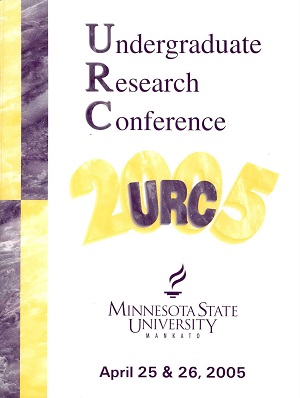Preliminary Characterization of Mycobacterium Paratuberculosis Cell Entry Protein
Location
CSU 255
Start Date
26-4-2005 10:00 AM
End Date
26-4-2005 12:00 PM
Student's Major
Biological Sciences
Student's College
Science, Engineering and Technology
Mentor's Name
Timothy E. Secott
Mentor's Department
Biological Sciences
Mentor's College
Science, Engineering and Technology
Description
Johne's disease which is caused by mycobacterium paratuberculosis (mpt) is an incurable, untreatable disease which afflicts domestic cattle, causing significant losses for the cattle industry. Elucidation of the mechanisms of pathogenesis employed by (mpt) is necessary to develop a viable means to eradicate this disease. Although research shows that the Fibronectin attachment protein (FA?) plays a pivotal role in the ability of (mpt) to invade host cells, it is evident that other factors need to be considered. Mycobacterium cell entry proteins (mcel) have been proposed as invasion factors used by mycobacterium tuberculosis, and similar genetic elements have been identified in (mpt). We have cloned this element and will present it's sequence in comparison with other pathogenic mycobacterium. Biometric algorithms will be used to predict the secondary structure of the nice product and its location in/oh the cell. Lastly we plan to fuse mce with a indicator gene (phoA) to attempt to determine the membrane topology of the mce product.
Preliminary Characterization of Mycobacterium Paratuberculosis Cell Entry Protein
CSU 255
Johne's disease which is caused by mycobacterium paratuberculosis (mpt) is an incurable, untreatable disease which afflicts domestic cattle, causing significant losses for the cattle industry. Elucidation of the mechanisms of pathogenesis employed by (mpt) is necessary to develop a viable means to eradicate this disease. Although research shows that the Fibronectin attachment protein (FA?) plays a pivotal role in the ability of (mpt) to invade host cells, it is evident that other factors need to be considered. Mycobacterium cell entry proteins (mcel) have been proposed as invasion factors used by mycobacterium tuberculosis, and similar genetic elements have been identified in (mpt). We have cloned this element and will present it's sequence in comparison with other pathogenic mycobacterium. Biometric algorithms will be used to predict the secondary structure of the nice product and its location in/oh the cell. Lastly we plan to fuse mce with a indicator gene (phoA) to attempt to determine the membrane topology of the mce product.



